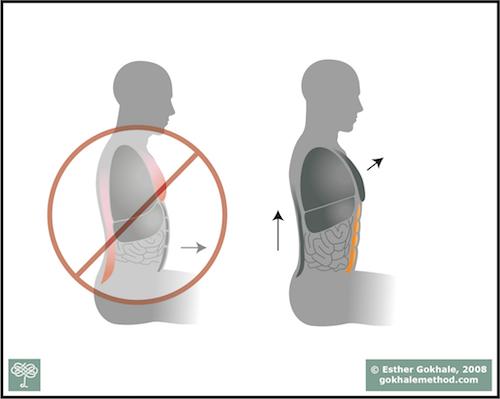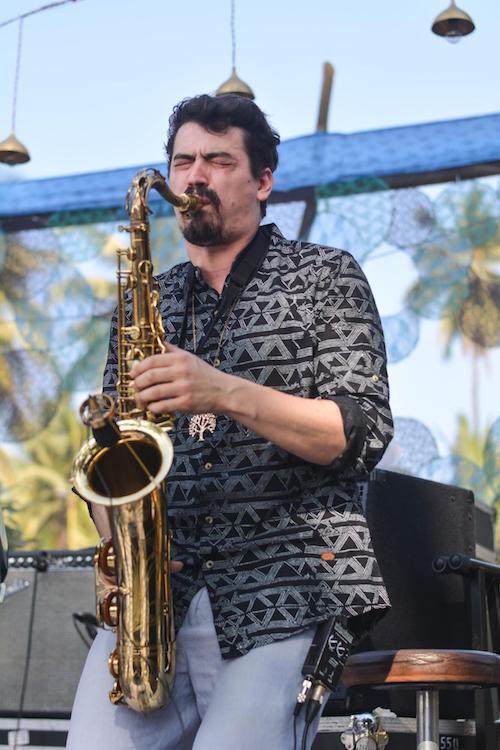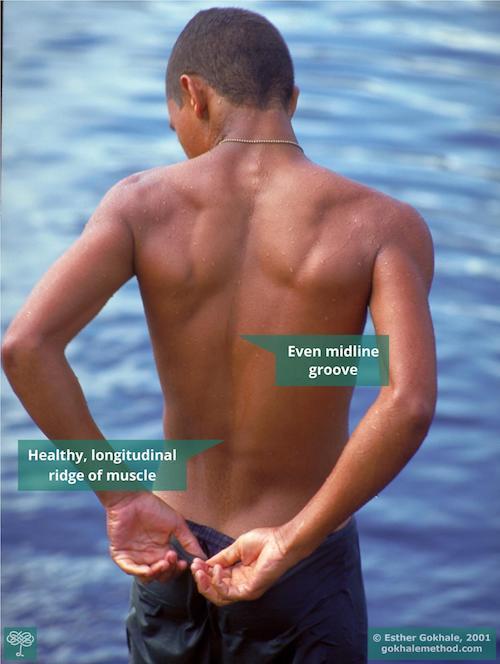Is Belly Breathing Good for You?
It’s common for students to arrive at our classes with strong notions about breathing. Among these is “Belly breathing is good breathing; chest breathing is bad breathing.” I disagree with this widespread belief and present varying amounts of pushback, counterargument, or hints about disagreement depending on the context and how much time I have.

Top: Chest lowered with exhalation. Bottom: Chest expanded with inhalation.
Sometimes I use a hand-waving argument: “Your lungs are housed in your chest; why wouldn’t they expand the chest on inhalation?” Sometimes I argue that if just the belly expands on breathing, that’s usually because the abdominal wall muscles are lax, the long back muscles (erector spinae) are tense, and the intercostal muscles have become stiff from lack of movement. Based on my experience with students, I predict that as the abs become more toned, the erector spinae muscles more relaxed, and the intercostal muscles more malleable, the default pattern of breathing will shift towards chest breathing and back breathing. Belly breathing is important, but only for special situations, like singing and playing the saxophone, where you need control of the diaphragm, or for when you exercise vigorously and need every avenue of expansion available.


Wind musicians, such as this saxophonist, rely upon diaphragm control while playing their instruments.
Photo courtesy Jyotirmoy Gupta.
My main argument that chest breathing and back breathing are normal defaults is the same as my argument for most things in posture: this is the way breathing is done in the populations we are emulating.
Sometimes it is challenging to gauge what a person’s default breathing pattern is. A baby’s breathing pattern varies depending on how she is positioned. We cannot observe ancestral populations live. So, we make observations where possible and best guesses everywhere else.

A baby sleeping on her back naturally defaults to chest breathing.
Photo courtesy Tara Raye.
The shape of one’s rib cage gives a clue about the person’s default breathing pattern. I often use the picture below of a carpenter from Burkina Faso, and explain that his expanded chest was shaped by the healthy “stress” of chest-breathing; belly breathing alone could not give him this kind of chest shape.

It takes the healthy stress of breathing in his chest, day in and day out, to fashion his kind of expanded rib cage. His abs are well-toned and don’t “give” as easily as his intercostal muscles and erector spinae muscles do when he inhales.
Back breathing
Healthy back musculature is also tell-tale of the natural rise and fall motion of the back that accompanies natural breathing. Nature provisioned us with the ability to keep the tissues around the spine in motion even when we are sedentary. The precious cargo that is contained in our torso is able to enjoy motion simply as a by-product of breathing. But this provision can be undermined by muscle tension in the back, or having the substantial weight of the upper body cantilevered forward. It takes a well-stacked spine and relaxed long back muscles to facilitate the natural motion of the back that accompanies breathing. Conversely, it takes the natural motion associated with breathing to relax and maintain healthy spinal tissues. When I traveled in Burkina Faso, I was struck by the resilient texture of people’s back musculature. And they were struck by a muscle knot in my shoulder I asked input for from a bone-setter (more details in my post Lessons I Learned From My Travels: Burkina Faso). I consider strong but malleable back musculature to be another sign of breathing done right. It’s rare in a modern setting.

This soldier taking a dip in Cachoeira, Brazil demonstrates what healthy back musculature and architecture look like.
Chest breathing vs. neck breathing
I have an educated guess about why chest breathing has gotten a bad rap: chest breathing is easily conflated with “neck breathing” — the anxiety-related breathing pattern that makes one’s shoulders move up with inhalation and down with exhalation. This pattern is, indeed, problematic. It results in tight scalenes, sternocleidomastoid muscles, and other neck/shoulder muscles, and causes pain and dysfunction. But let’s not throw the baby out with the bathwater by thinking chest breathing and problematic “neck breathing” are one and the same!
What we really need to do is to isolate chest breathing from neck breathing and enjoy the benefits of chest breathing without triggering tension in the neck and shoulders. We also need to learn to relax the back enough that it can move freely instead of the belly.
Cultivating a deeper awareness of our bodies is a useful feedback mechanism as we begin learning to isolate chest breathing from neck breathing and relax the back. In our Online University for graduates of our Gokhale Method Foundations course and Pop-Up courses, we discuss more advanced techniques for chest breathing. With these techniques, we too can have proud expanded chests and strong resilient backs, instead of aches and pains all around.

This unposed photo of a woman drying her laundry in Burkina Faso shows her expanded chest and healthy rib cage shape. These are a result of normal expansion of the chest with inhalation.
How often do you think about your breathing? Have you been trained to breathe in the chest? Back? Belly? Please share.

Comments
I have been expanding my
I have been expanding my pallet for the last year. I have an obstructed airway due to orthodontics in my youth. As part of this I have been in speech therapy where they have been teaching me butekyo breathing. They claim it is the healthiest way to breathe but it is difficult. I Have wondered why breathing would be difficult. It doesn’t make a lot of sense.
Agree. I have tried to learn
Agree. I have tried to learn Butekyo as well. It feels so unnatural and stressful. Having had orthodontics way back in the day your post makes me wonder if my anxiety breathing could be related. Thanks.
Esther, thank you so very
Esther, thank you so very much for this post. Thank you especially for having the courage to think independently. It takes a true scientist to be able to be open to new ways of thinking. I am not medically educated but I trust my intuition and when I read your words above, I just felt things fall into place for me and I felt "truth".
To this I would add that in my own research on the issue of breathing I learned that breathing in different ways affects the autonomic system. My understanding is that diaphragmatic breathing stimulates the parasympathetic (rest and repair) nervous system and upper chest breathing stimulates the sympathetic nervous system. Would you comment on this? I don't know if this is correct or not and after seeing your video of a sleeping child (who obviously is in "rest and repair mode") yet who is clearly breathing in the chest, I am doubting this little bit of "science" regarding the autonomic nervous system. I'm guessing that the sympathetic nervous system might be activated by neck tension and maybe that is what stimulates "fight or flight" mode. If that is the case, it feels to me that chest breathing - activating the entire chest cavity but not necessarily the diaphragm and not tensing the neck and shoulders - would be very balancing to the autonomic nervous system and allow your body to work with whatever is needed at that moment.
Again, thanks so much! xo
Bikram yoga does not
Bikram yoga does not explicitly discuss belly vs. chest breathing, but I think that implicitly it agrees with you, Esther, because the Bikram pranayama keeps the belly contracted during both inhalation and exhalation.
Thanks for posting this - I
Thanks for posting this - I found it really interesting and helpful.
Add New Comment
Login to add commment
Login